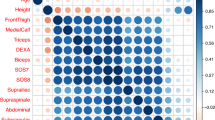Summary
Two hundred and seven male members of South Australian representative squads in 18 sports (¯X±s = 24.2±4.7 years) were tested in order to provide descriptive data on relative body fat (% BF), develop a population specific equation and cross-validate existing equations.
Measurements were taken of 10 circumferences, 2 diameters and 8 skinfolds; body density (BD) was measured by underwater weighing with the residual volume (RV) being determined by He dilution. The overall mean BD was 1.0761 g · cm−3 (s=0.0085 g·cm−3; range = 1.0465–1.0968 g·cm−3) which corresponded to 10.0% BF according to Siri (s=3.7%; range=1.3–23.0%). The games players (n=129) registered an overall mean of 10.3% BF (s=3.7%; range=2.2–23.0%). There were significant differences (p<0.05) for % BF between the lacrosse players (¯X=12.3%) and both the Australian Rules footballers (¯X=8.0%) and track and field athletes (¯X=8.7%).
A stepwise multiple regression on 185 subjects yielded the following equation, which had anR of 0.787:
BD=1.078865 -0.000419 (∑ abdominal, medial calf, front thigh and juxta-nipple skin-folds in mm)+0.000948 (neck circumference in cm)-0.000266 (age in decimal years)-0.000564 (ankle circumference in cm).
Only those predictors which resulted in a significantly increased correlation (p⩽0.05) were included. The standard error of estimate of 0.00537 g · cm−3 was equivalent to 2.3% BF at the mean. This equation was satisfactorily cross-validated against the BD of a separate sample (n=22) from the same population. However, cross-validation of 11 previously published equations indicated that they have limited applicability to State representative sportsmen.
Similar content being viewed by others
References
Carter JEL (1980) The Heath-Carter somatotype method. San Diego State University, San Diego, pp 2.3–2.4
Durnin JVGA, Taylor A (1960) Replicability of measurements of density of the human body as determined by underwater weighing. J Appl Physiol 15:142–144
Durnin JVGA, Womersley J (1974) Body fat assessed from total body density and its estimation from skinfold thickness: measurements on 481 men and women aged from 16 to 72 years. Br J Nutr 32:77–97
Forsyth HL, Sinning WE (1973) The anthropometric estimation of body density and lean body weight of male athletes. Med Sci Sports 5:174–180
Haisman MF (1970) The assessment of body fat content in young men from measurements of body density and skin-fold thickness. Hum Biol 42:679–688
Jackson AS, Pollock ML (1978) Generalized equations for predicting body density of men. Br J Nutr 40:497–504
Jackson AS, Pollock ML, Gettman LR (1978) Intertester reliability of selected skinfold and circumference measurements and percent fat estimates. Res Quart 49:546–551
Katch FI, McArdle WD (1973) Prediction of body density from simple anthropometric measurements in college-age men and women. Hum Biol 45:445–454
Keys A, Brožek, J (1953) Body fat in adult man. Physiol Rev 33:245–325
Lohman TG (1981) Skinfolds and body density and their relation to body fatness: a review. Hum Biol 53:181–225
Pollock ML, Hickman T, Kendrick Z, Jackson A, Linnerud AC, Dawson G (1976) Prediction of body density in young and middle-aged men. J Appl Physiol 40:300–304
Pollock ML, Ayres J, Ward A, Jackson A, Linnerud AC (1978) Measurement and prediction of body density in elite runners. In: Landry F, Orban WAR (eds) Biomechanics of sports and kinanthropometry, book 6. Symposia Specialists Inc, Florida, pp 313–320
Ross WD, Marfell-Jones MJ (1982) Kinanthropometry. In: MacDougall JD, Wenger HA, Green HJ (eds) Physiological testing of the elite athlete. Mutual Press Ltd, Canada, pp 75–115
Siri WE (1961) Body composition from fluid spaces and density: analysis of methods. In: Brokzek J, Henschel A (eds) Techniques for measuring body composition. National Academy of Sciences National Research Council, Washington, D.C., pp 223–244
Sloan AW (1967) Estimation of body fat in young men. J Appl Physiol 23:311–315
Smith JF, Mansfield ER (1984) Body composition prediction in university football players. Med Sci Sports Exerc 16:398–405
Wickkiser JD, Kelly JM (1975) The body composition of a college football team. Med Sci Sports 7:199–202
Wilmore JH, Behnke AR (1969) An anthropometric estimation of body density and lean body weight in young men. J Appl Physiol 27:25–31
Wilmore JH, Haskell WL (1972) Body composition and endurance capacity of professional football players. J Appl Physiol 33:564–567
Withers RT, Whittingham NO, Norton KI, La Forgia J, Ellis MW, Crockett A (1987) Relative body fat and anthropometric prediction of body density of female athletes. Eur J Appl Physiol 56:169–180
Author information
Authors and Affiliations
Additional information
This study was supported by a grant from the Menzies Foundation
Rights and permissions
About this article
Cite this article
Withers, R.T., Craig, N.P., Bourdon, P.C. et al. Relative body fat and anthropometric prediction of body density of male athletes. Europ. J. Appl. Physiol. 56, 191–200 (1987). https://doi.org/10.1007/BF00640643
Accepted:
Issue Date:
DOI: https://doi.org/10.1007/BF00640643




